A Comprehensive Analysis of the User Pays Model in Aged Care
VerifiedAdded on 2023/06/12
|8
|2139
|84
Essay
AI Summary
This essay examines the user pays model in aged care, focusing on its implementation in Australia. It discusses the advantages and disadvantages of the model, including issues such as long queues in public hospitals and the financial burden on the elderly. The essay highlights government policies aimed at improving aged care, such as increased funding for community-based healthcare and incentives for family members who provide care. Furthermore, it proposes recommendations for enhancing aged care, including promoting healthy lifestyles for the elderly and providing financial and social support. The conclusion emphasizes the need for a dignified life for elders and suggests that the Australian model, while efficient, requires continuous improvement to ensure accessible and affordable healthcare for the aging population. Desklib offers a variety of resources for students studying healthcare and social policy.
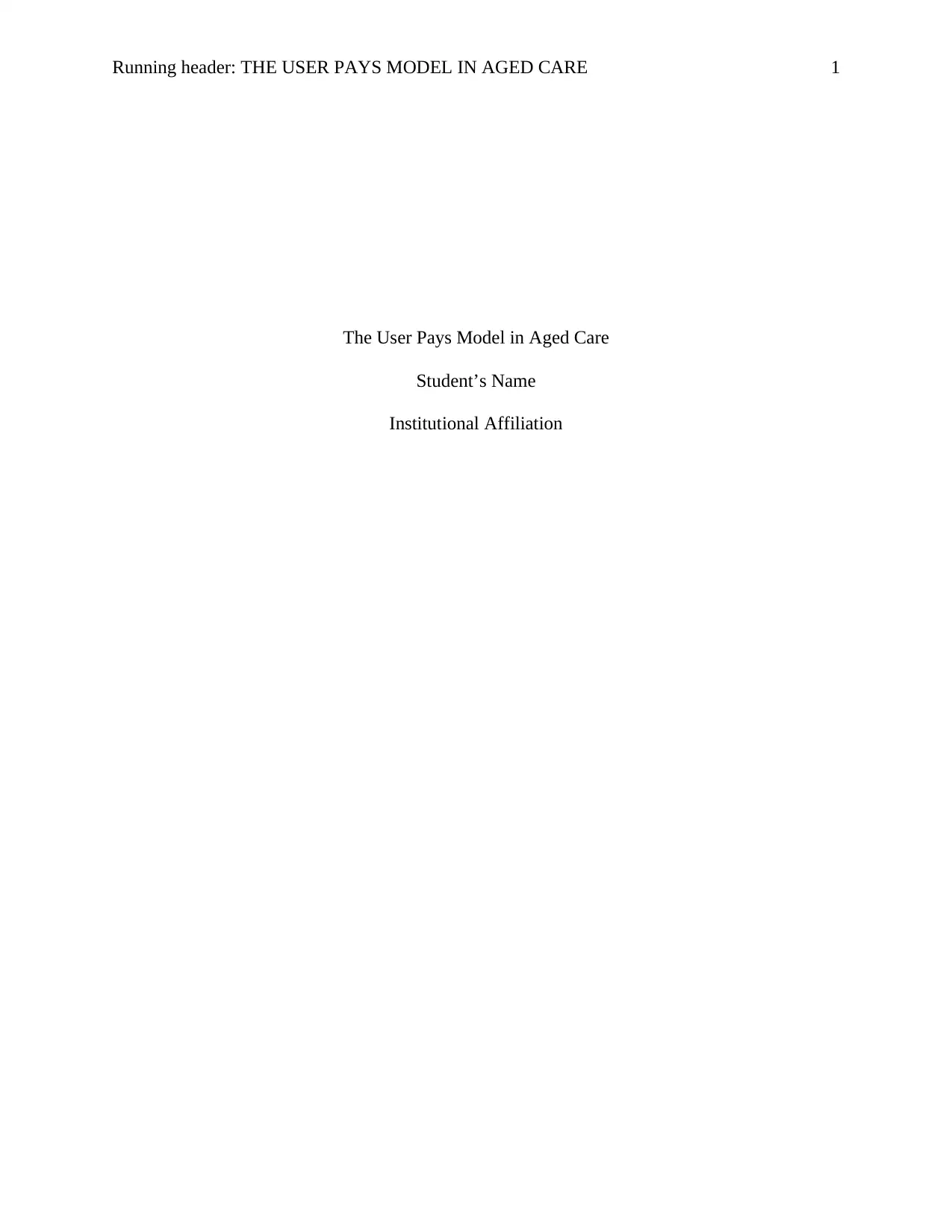
Running header: THE USER PAYS MODEL IN AGED CARE 1
The User Pays Model in Aged Care
Student’s Name
Institutional Affiliation
The User Pays Model in Aged Care
Student’s Name
Institutional Affiliation
Paraphrase This Document
Need a fresh take? Get an instant paraphrase of this document with our AI Paraphraser
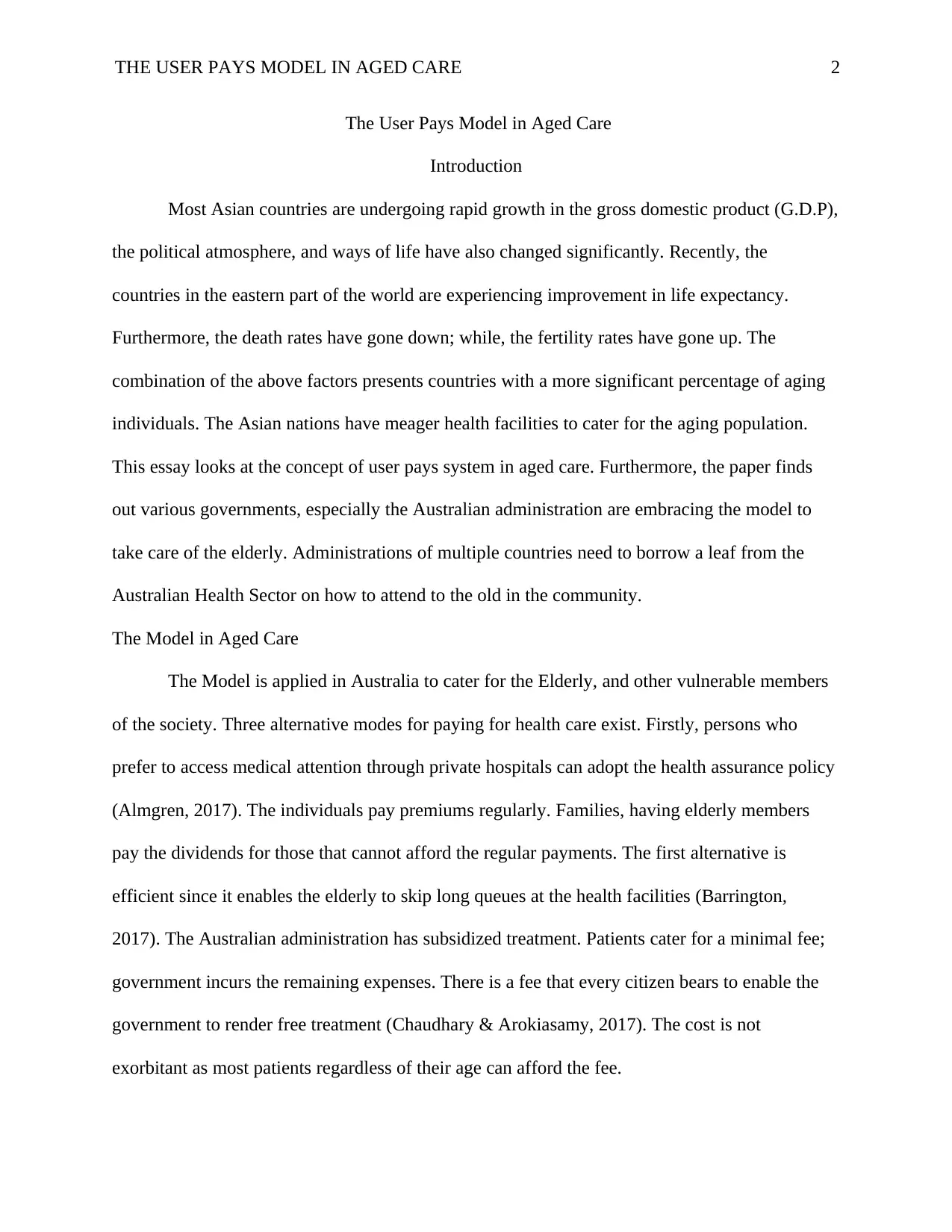
THE USER PAYS MODEL IN AGED CARE 2
The User Pays Model in Aged Care
Introduction
Most Asian countries are undergoing rapid growth in the gross domestic product (G.D.P),
the political atmosphere, and ways of life have also changed significantly. Recently, the
countries in the eastern part of the world are experiencing improvement in life expectancy.
Furthermore, the death rates have gone down; while, the fertility rates have gone up. The
combination of the above factors presents countries with a more significant percentage of aging
individuals. The Asian nations have meager health facilities to cater for the aging population.
This essay looks at the concept of user pays system in aged care. Furthermore, the paper finds
out various governments, especially the Australian administration are embracing the model to
take care of the elderly. Administrations of multiple countries need to borrow a leaf from the
Australian Health Sector on how to attend to the old in the community.
The Model in Aged Care
The Model is applied in Australia to cater for the Elderly, and other vulnerable members
of the society. Three alternative modes for paying for health care exist. Firstly, persons who
prefer to access medical attention through private hospitals can adopt the health assurance policy
(Almgren, 2017). The individuals pay premiums regularly. Families, having elderly members
pay the dividends for those that cannot afford the regular payments. The first alternative is
efficient since it enables the elderly to skip long queues at the health facilities (Barrington,
2017). The Australian administration has subsidized treatment. Patients cater for a minimal fee;
government incurs the remaining expenses. There is a fee that every citizen bears to enable the
government to render free treatment (Chaudhary & Arokiasamy, 2017). The cost is not
exorbitant as most patients regardless of their age can afford the fee.
The User Pays Model in Aged Care
Introduction
Most Asian countries are undergoing rapid growth in the gross domestic product (G.D.P),
the political atmosphere, and ways of life have also changed significantly. Recently, the
countries in the eastern part of the world are experiencing improvement in life expectancy.
Furthermore, the death rates have gone down; while, the fertility rates have gone up. The
combination of the above factors presents countries with a more significant percentage of aging
individuals. The Asian nations have meager health facilities to cater for the aging population.
This essay looks at the concept of user pays system in aged care. Furthermore, the paper finds
out various governments, especially the Australian administration are embracing the model to
take care of the elderly. Administrations of multiple countries need to borrow a leaf from the
Australian Health Sector on how to attend to the old in the community.
The Model in Aged Care
The Model is applied in Australia to cater for the Elderly, and other vulnerable members
of the society. Three alternative modes for paying for health care exist. Firstly, persons who
prefer to access medical attention through private hospitals can adopt the health assurance policy
(Almgren, 2017). The individuals pay premiums regularly. Families, having elderly members
pay the dividends for those that cannot afford the regular payments. The first alternative is
efficient since it enables the elderly to skip long queues at the health facilities (Barrington,
2017). The Australian administration has subsidized treatment. Patients cater for a minimal fee;
government incurs the remaining expenses. There is a fee that every citizen bears to enable the
government to render free treatment (Chaudhary & Arokiasamy, 2017). The cost is not
exorbitant as most patients regardless of their age can afford the fee.
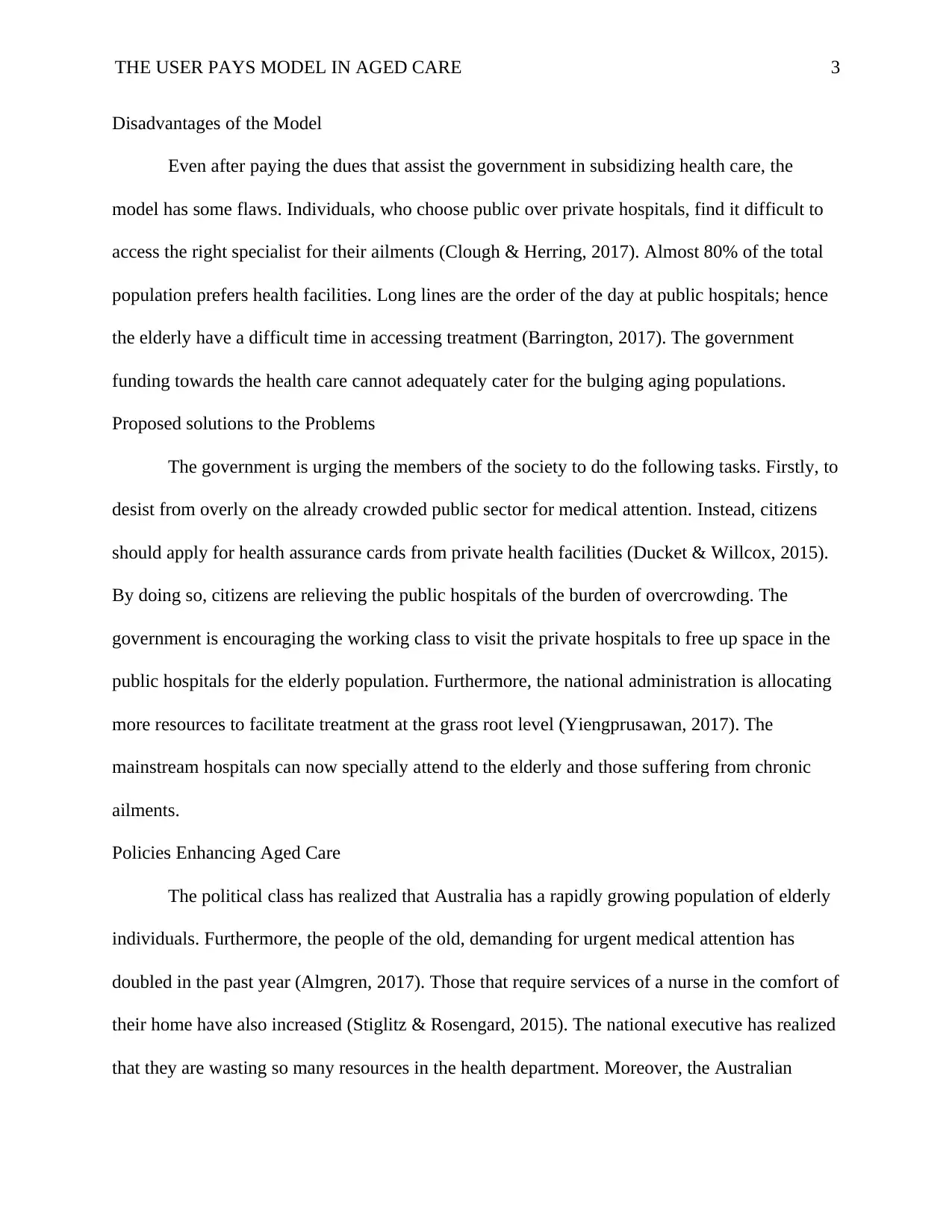
THE USER PAYS MODEL IN AGED CARE 3
Disadvantages of the Model
Even after paying the dues that assist the government in subsidizing health care, the
model has some flaws. Individuals, who choose public over private hospitals, find it difficult to
access the right specialist for their ailments (Clough & Herring, 2017). Almost 80% of the total
population prefers health facilities. Long lines are the order of the day at public hospitals; hence
the elderly have a difficult time in accessing treatment (Barrington, 2017). The government
funding towards the health care cannot adequately cater for the bulging aging populations.
Proposed solutions to the Problems
The government is urging the members of the society to do the following tasks. Firstly, to
desist from overly on the already crowded public sector for medical attention. Instead, citizens
should apply for health assurance cards from private health facilities (Ducket & Willcox, 2015).
By doing so, citizens are relieving the public hospitals of the burden of overcrowding. The
government is encouraging the working class to visit the private hospitals to free up space in the
public hospitals for the elderly population. Furthermore, the national administration is allocating
more resources to facilitate treatment at the grass root level (Yiengprusawan, 2017). The
mainstream hospitals can now specially attend to the elderly and those suffering from chronic
ailments.
Policies Enhancing Aged Care
The political class has realized that Australia has a rapidly growing population of elderly
individuals. Furthermore, the people of the old, demanding for urgent medical attention has
doubled in the past year (Almgren, 2017). Those that require services of a nurse in the comfort of
their home have also increased (Stiglitz & Rosengard, 2015). The national executive has realized
that they are wasting so many resources in the health department. Moreover, the Australian
Disadvantages of the Model
Even after paying the dues that assist the government in subsidizing health care, the
model has some flaws. Individuals, who choose public over private hospitals, find it difficult to
access the right specialist for their ailments (Clough & Herring, 2017). Almost 80% of the total
population prefers health facilities. Long lines are the order of the day at public hospitals; hence
the elderly have a difficult time in accessing treatment (Barrington, 2017). The government
funding towards the health care cannot adequately cater for the bulging aging populations.
Proposed solutions to the Problems
The government is urging the members of the society to do the following tasks. Firstly, to
desist from overly on the already crowded public sector for medical attention. Instead, citizens
should apply for health assurance cards from private health facilities (Ducket & Willcox, 2015).
By doing so, citizens are relieving the public hospitals of the burden of overcrowding. The
government is encouraging the working class to visit the private hospitals to free up space in the
public hospitals for the elderly population. Furthermore, the national administration is allocating
more resources to facilitate treatment at the grass root level (Yiengprusawan, 2017). The
mainstream hospitals can now specially attend to the elderly and those suffering from chronic
ailments.
Policies Enhancing Aged Care
The political class has realized that Australia has a rapidly growing population of elderly
individuals. Furthermore, the people of the old, demanding for urgent medical attention has
doubled in the past year (Almgren, 2017). Those that require services of a nurse in the comfort of
their home have also increased (Stiglitz & Rosengard, 2015). The national executive has realized
that they are wasting so many resources in the health department. Moreover, the Australian
⊘ This is a preview!⊘
Do you want full access?
Subscribe today to unlock all pages.

Trusted by 1+ million students worldwide
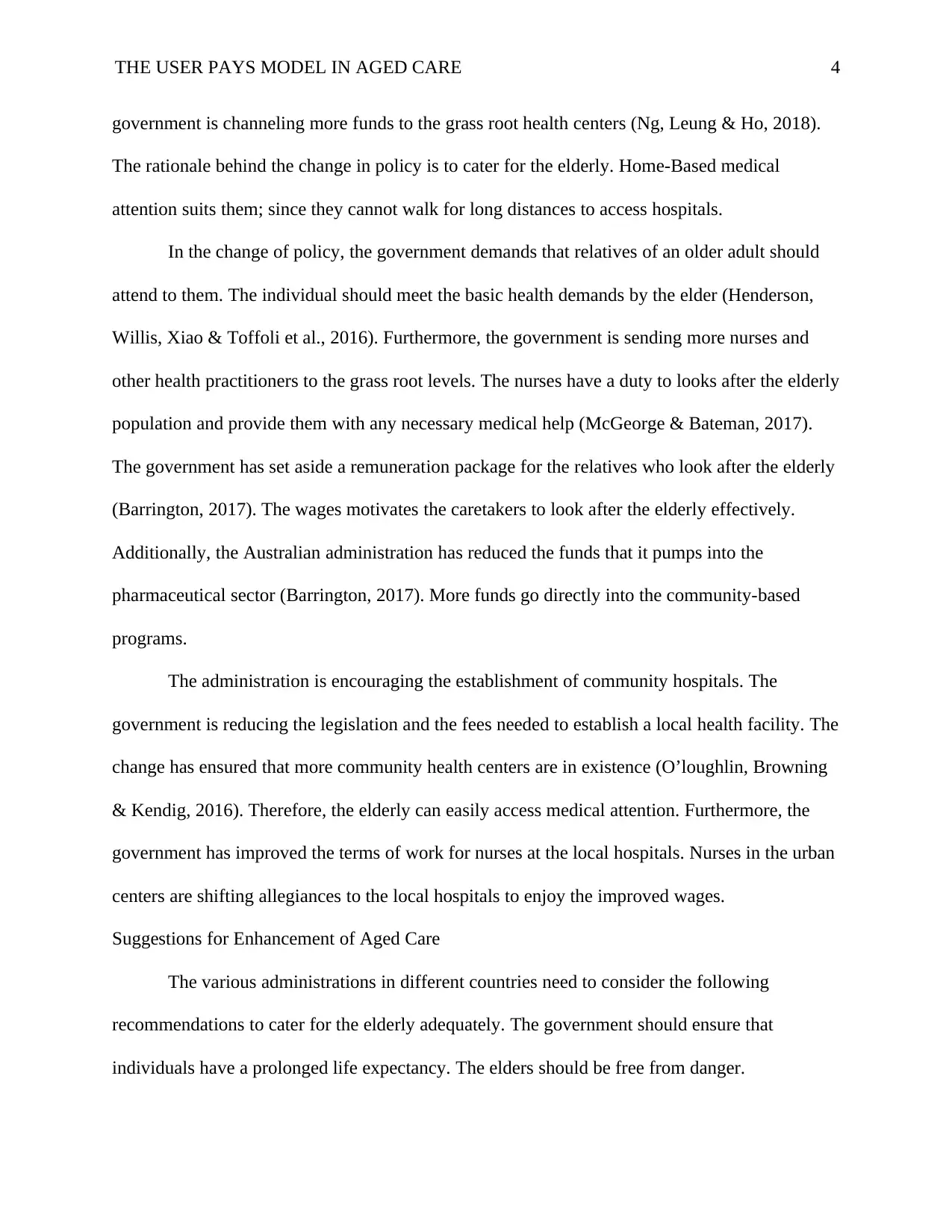
THE USER PAYS MODEL IN AGED CARE 4
government is channeling more funds to the grass root health centers (Ng, Leung & Ho, 2018).
The rationale behind the change in policy is to cater for the elderly. Home-Based medical
attention suits them; since they cannot walk for long distances to access hospitals.
In the change of policy, the government demands that relatives of an older adult should
attend to them. The individual should meet the basic health demands by the elder (Henderson,
Willis, Xiao & Toffoli et al., 2016). Furthermore, the government is sending more nurses and
other health practitioners to the grass root levels. The nurses have a duty to looks after the elderly
population and provide them with any necessary medical help (McGeorge & Bateman, 2017).
The government has set aside a remuneration package for the relatives who look after the elderly
(Barrington, 2017). The wages motivates the caretakers to look after the elderly effectively.
Additionally, the Australian administration has reduced the funds that it pumps into the
pharmaceutical sector (Barrington, 2017). More funds go directly into the community-based
programs.
The administration is encouraging the establishment of community hospitals. The
government is reducing the legislation and the fees needed to establish a local health facility. The
change has ensured that more community health centers are in existence (O’loughlin, Browning
& Kendig, 2016). Therefore, the elderly can easily access medical attention. Furthermore, the
government has improved the terms of work for nurses at the local hospitals. Nurses in the urban
centers are shifting allegiances to the local hospitals to enjoy the improved wages.
Suggestions for Enhancement of Aged Care
The various administrations in different countries need to consider the following
recommendations to cater for the elderly adequately. The government should ensure that
individuals have a prolonged life expectancy. The elders should be free from danger.
government is channeling more funds to the grass root health centers (Ng, Leung & Ho, 2018).
The rationale behind the change in policy is to cater for the elderly. Home-Based medical
attention suits them; since they cannot walk for long distances to access hospitals.
In the change of policy, the government demands that relatives of an older adult should
attend to them. The individual should meet the basic health demands by the elder (Henderson,
Willis, Xiao & Toffoli et al., 2016). Furthermore, the government is sending more nurses and
other health practitioners to the grass root levels. The nurses have a duty to looks after the elderly
population and provide them with any necessary medical help (McGeorge & Bateman, 2017).
The government has set aside a remuneration package for the relatives who look after the elderly
(Barrington, 2017). The wages motivates the caretakers to look after the elderly effectively.
Additionally, the Australian administration has reduced the funds that it pumps into the
pharmaceutical sector (Barrington, 2017). More funds go directly into the community-based
programs.
The administration is encouraging the establishment of community hospitals. The
government is reducing the legislation and the fees needed to establish a local health facility. The
change has ensured that more community health centers are in existence (O’loughlin, Browning
& Kendig, 2016). Therefore, the elderly can easily access medical attention. Furthermore, the
government has improved the terms of work for nurses at the local hospitals. Nurses in the urban
centers are shifting allegiances to the local hospitals to enjoy the improved wages.
Suggestions for Enhancement of Aged Care
The various administrations in different countries need to consider the following
recommendations to cater for the elderly adequately. The government should ensure that
individuals have a prolonged life expectancy. The elders should be free from danger.
Paraphrase This Document
Need a fresh take? Get an instant paraphrase of this document with our AI Paraphraser
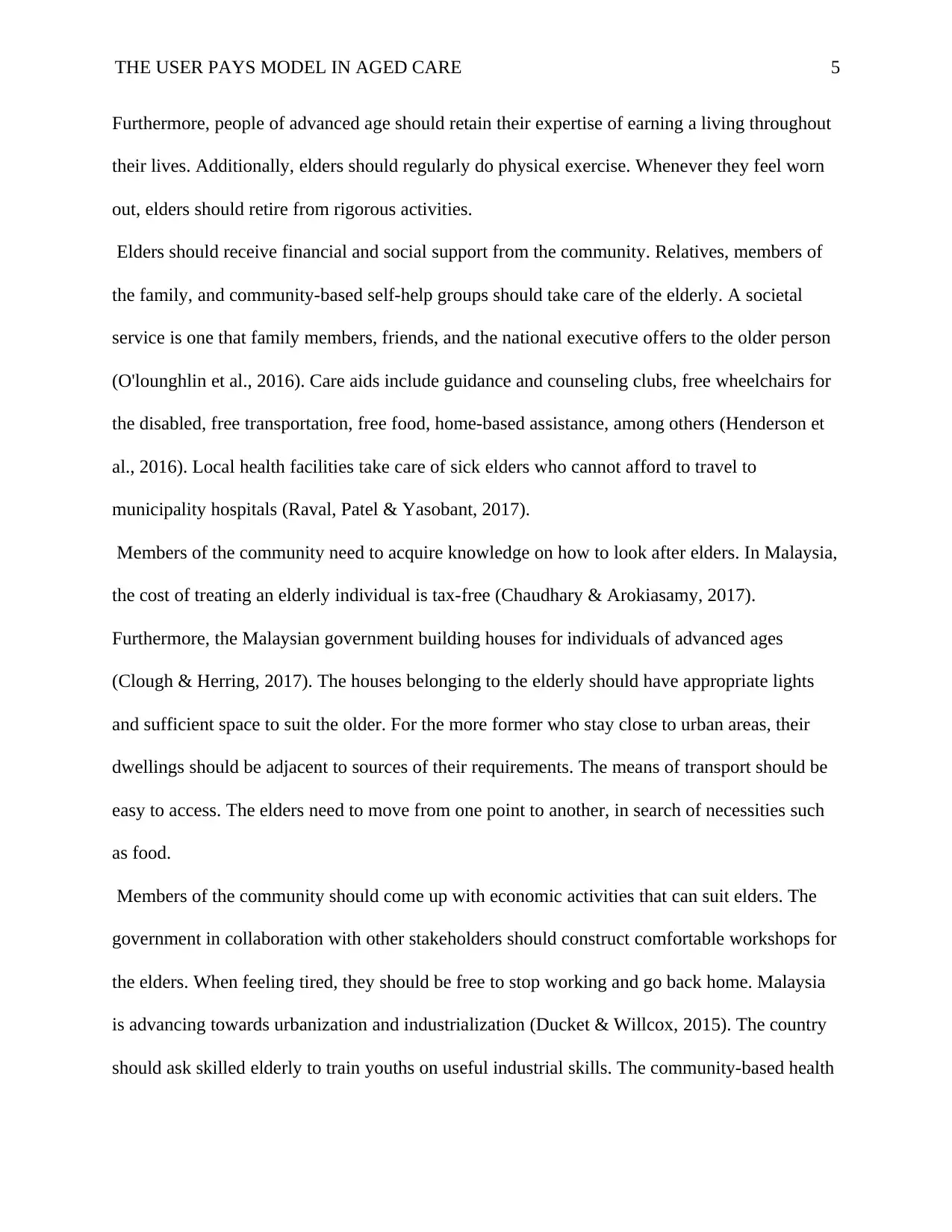
THE USER PAYS MODEL IN AGED CARE 5
Furthermore, people of advanced age should retain their expertise of earning a living throughout
their lives. Additionally, elders should regularly do physical exercise. Whenever they feel worn
out, elders should retire from rigorous activities.
Elders should receive financial and social support from the community. Relatives, members of
the family, and community-based self-help groups should take care of the elderly. A societal
service is one that family members, friends, and the national executive offers to the older person
(O'lounghlin et al., 2016). Care aids include guidance and counseling clubs, free wheelchairs for
the disabled, free transportation, free food, home-based assistance, among others (Henderson et
al., 2016). Local health facilities take care of sick elders who cannot afford to travel to
municipality hospitals (Raval, Patel & Yasobant, 2017).
Members of the community need to acquire knowledge on how to look after elders. In Malaysia,
the cost of treating an elderly individual is tax-free (Chaudhary & Arokiasamy, 2017).
Furthermore, the Malaysian government building houses for individuals of advanced ages
(Clough & Herring, 2017). The houses belonging to the elderly should have appropriate lights
and sufficient space to suit the older. For the more former who stay close to urban areas, their
dwellings should be adjacent to sources of their requirements. The means of transport should be
easy to access. The elders need to move from one point to another, in search of necessities such
as food.
Members of the community should come up with economic activities that can suit elders. The
government in collaboration with other stakeholders should construct comfortable workshops for
the elders. When feeling tired, they should be free to stop working and go back home. Malaysia
is advancing towards urbanization and industrialization (Ducket & Willcox, 2015). The country
should ask skilled elderly to train youths on useful industrial skills. The community-based health
Furthermore, people of advanced age should retain their expertise of earning a living throughout
their lives. Additionally, elders should regularly do physical exercise. Whenever they feel worn
out, elders should retire from rigorous activities.
Elders should receive financial and social support from the community. Relatives, members of
the family, and community-based self-help groups should take care of the elderly. A societal
service is one that family members, friends, and the national executive offers to the older person
(O'lounghlin et al., 2016). Care aids include guidance and counseling clubs, free wheelchairs for
the disabled, free transportation, free food, home-based assistance, among others (Henderson et
al., 2016). Local health facilities take care of sick elders who cannot afford to travel to
municipality hospitals (Raval, Patel & Yasobant, 2017).
Members of the community need to acquire knowledge on how to look after elders. In Malaysia,
the cost of treating an elderly individual is tax-free (Chaudhary & Arokiasamy, 2017).
Furthermore, the Malaysian government building houses for individuals of advanced ages
(Clough & Herring, 2017). The houses belonging to the elderly should have appropriate lights
and sufficient space to suit the older. For the more former who stay close to urban areas, their
dwellings should be adjacent to sources of their requirements. The means of transport should be
easy to access. The elders need to move from one point to another, in search of necessities such
as food.
Members of the community should come up with economic activities that can suit elders. The
government in collaboration with other stakeholders should construct comfortable workshops for
the elders. When feeling tired, they should be free to stop working and go back home. Malaysia
is advancing towards urbanization and industrialization (Ducket & Willcox, 2015). The country
should ask skilled elderly to train youths on useful industrial skills. The community-based health
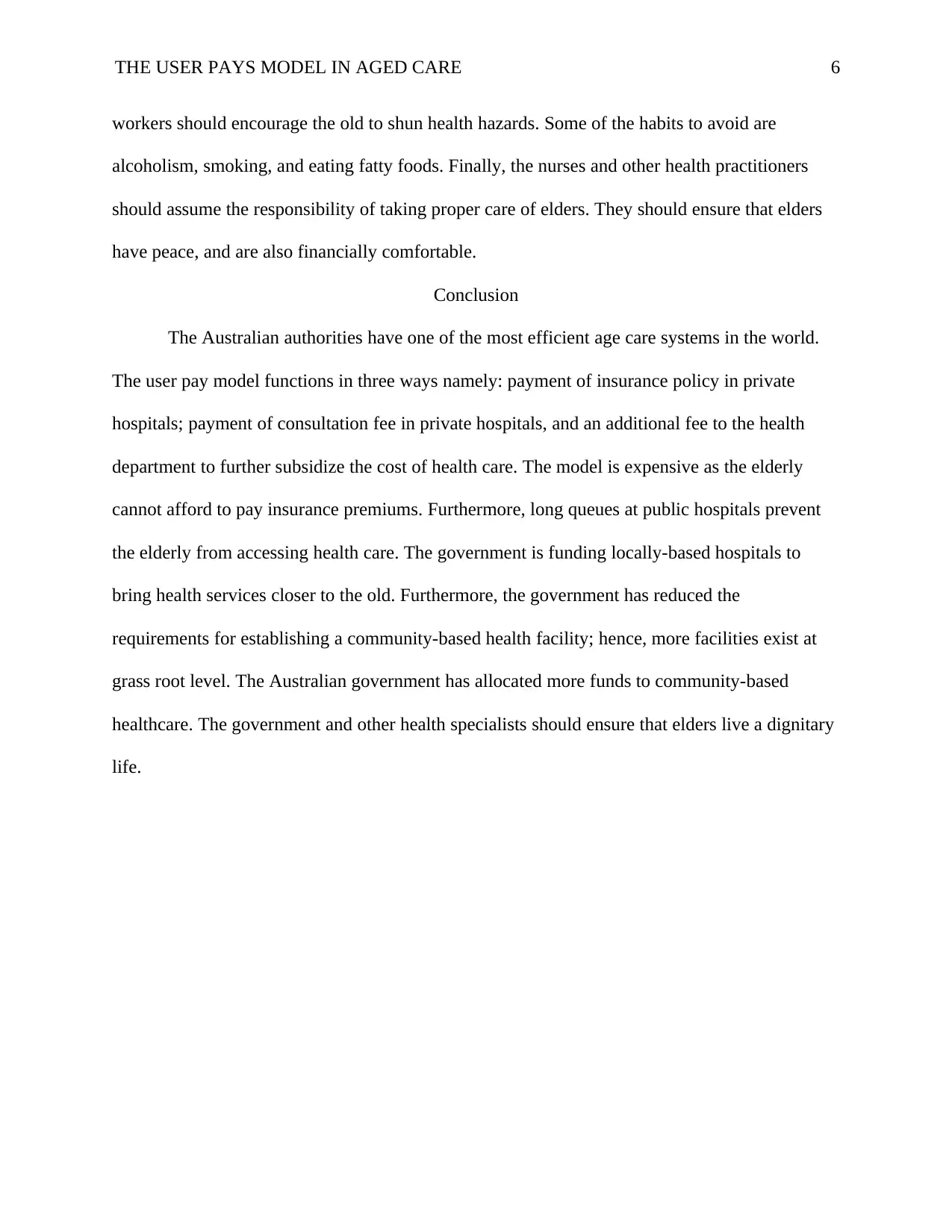
THE USER PAYS MODEL IN AGED CARE 6
workers should encourage the old to shun health hazards. Some of the habits to avoid are
alcoholism, smoking, and eating fatty foods. Finally, the nurses and other health practitioners
should assume the responsibility of taking proper care of elders. They should ensure that elders
have peace, and are also financially comfortable.
Conclusion
The Australian authorities have one of the most efficient age care systems in the world.
The user pay model functions in three ways namely: payment of insurance policy in private
hospitals; payment of consultation fee in private hospitals, and an additional fee to the health
department to further subsidize the cost of health care. The model is expensive as the elderly
cannot afford to pay insurance premiums. Furthermore, long queues at public hospitals prevent
the elderly from accessing health care. The government is funding locally-based hospitals to
bring health services closer to the old. Furthermore, the government has reduced the
requirements for establishing a community-based health facility; hence, more facilities exist at
grass root level. The Australian government has allocated more funds to community-based
healthcare. The government and other health specialists should ensure that elders live a dignitary
life.
workers should encourage the old to shun health hazards. Some of the habits to avoid are
alcoholism, smoking, and eating fatty foods. Finally, the nurses and other health practitioners
should assume the responsibility of taking proper care of elders. They should ensure that elders
have peace, and are also financially comfortable.
Conclusion
The Australian authorities have one of the most efficient age care systems in the world.
The user pay model functions in three ways namely: payment of insurance policy in private
hospitals; payment of consultation fee in private hospitals, and an additional fee to the health
department to further subsidize the cost of health care. The model is expensive as the elderly
cannot afford to pay insurance premiums. Furthermore, long queues at public hospitals prevent
the elderly from accessing health care. The government is funding locally-based hospitals to
bring health services closer to the old. Furthermore, the government has reduced the
requirements for establishing a community-based health facility; hence, more facilities exist at
grass root level. The Australian government has allocated more funds to community-based
healthcare. The government and other health specialists should ensure that elders live a dignitary
life.
⊘ This is a preview!⊘
Do you want full access?
Subscribe today to unlock all pages.

Trusted by 1+ million students worldwide
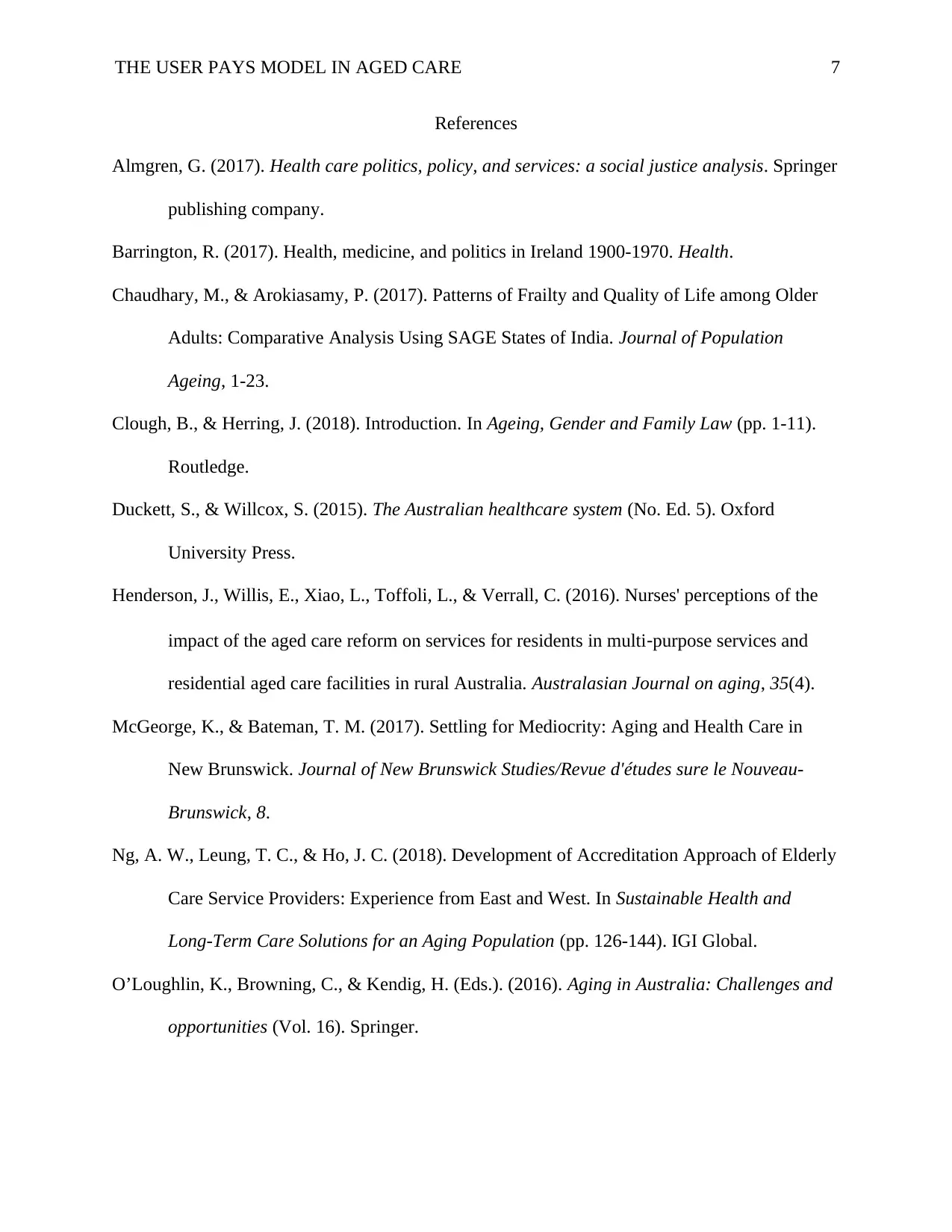
THE USER PAYS MODEL IN AGED CARE 7
References
Almgren, G. (2017). Health care politics, policy, and services: a social justice analysis. Springer
publishing company.
Barrington, R. (2017). Health, medicine, and politics in Ireland 1900-1970. Health.
Chaudhary, M., & Arokiasamy, P. (2017). Patterns of Frailty and Quality of Life among Older
Adults: Comparative Analysis Using SAGE States of India. Journal of Population
Ageing, 1-23.
Clough, B., & Herring, J. (2018). Introduction. In Ageing, Gender and Family Law (pp. 1-11).
Routledge.
Duckett, S., & Willcox, S. (2015). The Australian healthcare system (No. Ed. 5). Oxford
University Press.
Henderson, J., Willis, E., Xiao, L., Toffoli, L., & Verrall, C. (2016). Nurses' perceptions of the
impact of the aged care reform on services for residents in multi‐purpose services and
residential aged care facilities in rural Australia. Australasian Journal on aging, 35(4).
McGeorge, K., & Bateman, T. M. (2017). Settling for Mediocrity: Aging and Health Care in
New Brunswick. Journal of New Brunswick Studies/Revue d'études sure le Nouveau-
Brunswick, 8.
Ng, A. W., Leung, T. C., & Ho, J. C. (2018). Development of Accreditation Approach of Elderly
Care Service Providers: Experience from East and West. In Sustainable Health and
Long-Term Care Solutions for an Aging Population (pp. 126-144). IGI Global.
O’Loughlin, K., Browning, C., & Kendig, H. (Eds.). (2016). Aging in Australia: Challenges and
opportunities (Vol. 16). Springer.
References
Almgren, G. (2017). Health care politics, policy, and services: a social justice analysis. Springer
publishing company.
Barrington, R. (2017). Health, medicine, and politics in Ireland 1900-1970. Health.
Chaudhary, M., & Arokiasamy, P. (2017). Patterns of Frailty and Quality of Life among Older
Adults: Comparative Analysis Using SAGE States of India. Journal of Population
Ageing, 1-23.
Clough, B., & Herring, J. (2018). Introduction. In Ageing, Gender and Family Law (pp. 1-11).
Routledge.
Duckett, S., & Willcox, S. (2015). The Australian healthcare system (No. Ed. 5). Oxford
University Press.
Henderson, J., Willis, E., Xiao, L., Toffoli, L., & Verrall, C. (2016). Nurses' perceptions of the
impact of the aged care reform on services for residents in multi‐purpose services and
residential aged care facilities in rural Australia. Australasian Journal on aging, 35(4).
McGeorge, K., & Bateman, T. M. (2017). Settling for Mediocrity: Aging and Health Care in
New Brunswick. Journal of New Brunswick Studies/Revue d'études sure le Nouveau-
Brunswick, 8.
Ng, A. W., Leung, T. C., & Ho, J. C. (2018). Development of Accreditation Approach of Elderly
Care Service Providers: Experience from East and West. In Sustainable Health and
Long-Term Care Solutions for an Aging Population (pp. 126-144). IGI Global.
O’Loughlin, K., Browning, C., & Kendig, H. (Eds.). (2016). Aging in Australia: Challenges and
opportunities (Vol. 16). Springer.
Paraphrase This Document
Need a fresh take? Get an instant paraphrase of this document with our AI Paraphraser
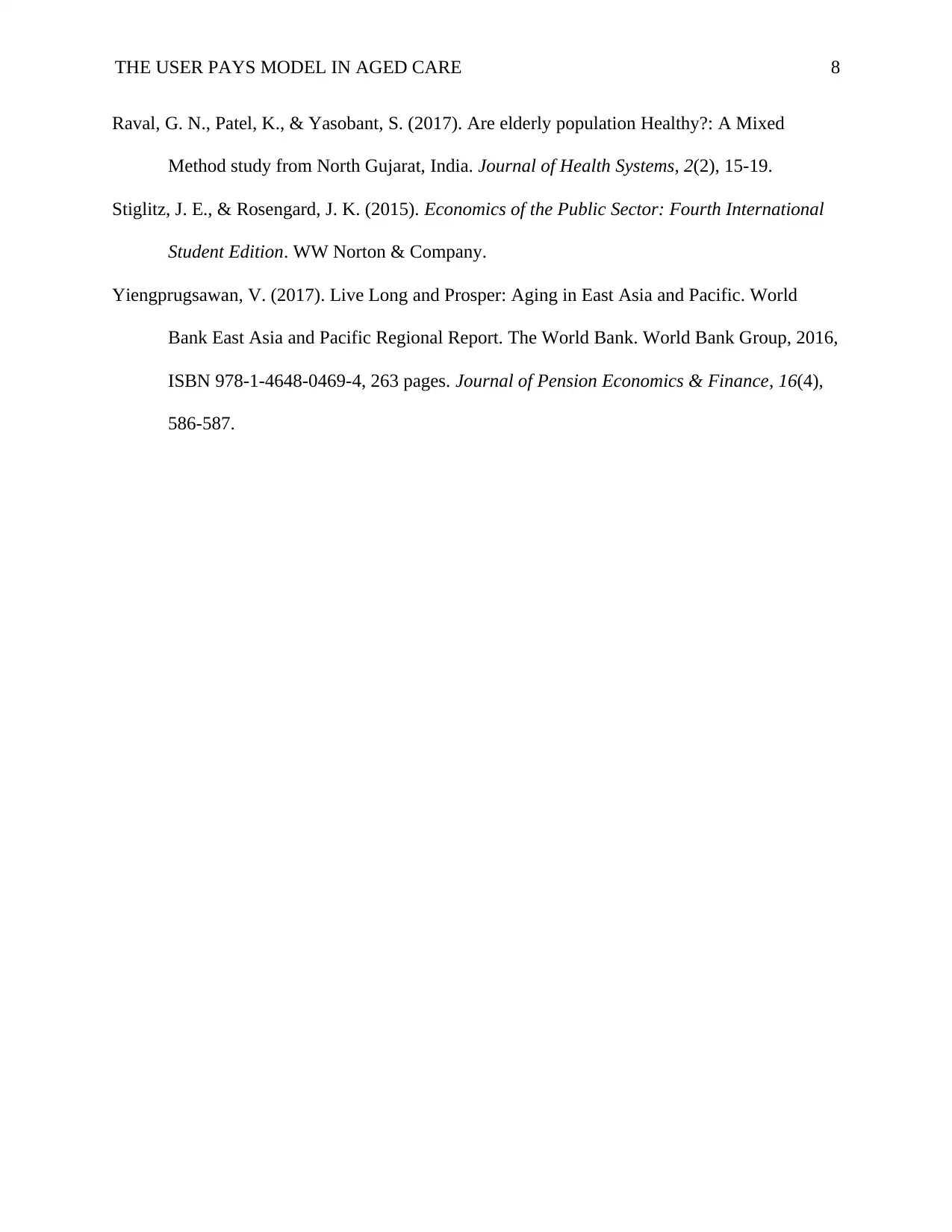
THE USER PAYS MODEL IN AGED CARE 8
Raval, G. N., Patel, K., & Yasobant, S. (2017). Are elderly population Healthy?: A Mixed
Method study from North Gujarat, India. Journal of Health Systems, 2(2), 15-19.
Stiglitz, J. E., & Rosengard, J. K. (2015). Economics of the Public Sector: Fourth International
Student Edition. WW Norton & Company.
Yiengprugsawan, V. (2017). Live Long and Prosper: Aging in East Asia and Pacific. World
Bank East Asia and Pacific Regional Report. The World Bank. World Bank Group, 2016,
ISBN 978-1-4648-0469-4, 263 pages. Journal of Pension Economics & Finance, 16(4),
586-587.
Raval, G. N., Patel, K., & Yasobant, S. (2017). Are elderly population Healthy?: A Mixed
Method study from North Gujarat, India. Journal of Health Systems, 2(2), 15-19.
Stiglitz, J. E., & Rosengard, J. K. (2015). Economics of the Public Sector: Fourth International
Student Edition. WW Norton & Company.
Yiengprugsawan, V. (2017). Live Long and Prosper: Aging in East Asia and Pacific. World
Bank East Asia and Pacific Regional Report. The World Bank. World Bank Group, 2016,
ISBN 978-1-4648-0469-4, 263 pages. Journal of Pension Economics & Finance, 16(4),
586-587.
1 out of 8
Related Documents
Your All-in-One AI-Powered Toolkit for Academic Success.
+13062052269
info@desklib.com
Available 24*7 on WhatsApp / Email
![[object Object]](/_next/static/media/star-bottom.7253800d.svg)
Unlock your academic potential
Copyright © 2020–2025 A2Z Services. All Rights Reserved. Developed and managed by ZUCOL.





